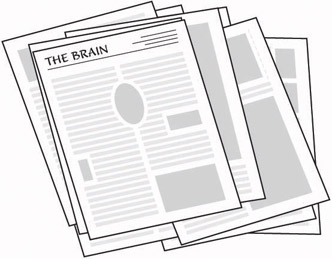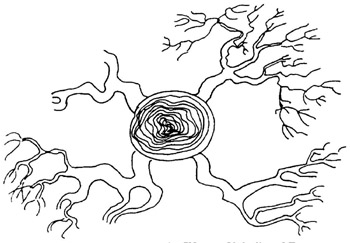the use of keywords
The funny thing with these maps is that no one will resemble another in spite of the fact that you may all have the same starting-point, the same text, the same lecture, and still the maps will be totally different from one person to another. This is perfectly natural as we all are different, we think differently, have different experiences and knowledge, we have different backgrounds, etc.
As a result of this, when you develop your own personal style you will find you can easily recall the information, the words and the pictures your map contains.
Most people take down too many words in linear, ˜normal notes, which inevitably leads to problems. It takes more time to revise the notes and to find the structure in them. Linear notes are related to time, which means the information is recorded depending on when you read or heard it. There is no easy way of putting information from one part in context with information from other parts .
Using learning maps you will notice you need to remember very few words. Concentrate on the right words, those that lead to a better recall. Finding these right words or keywords is a skill you develop using learning maps as your note-taking technique.
The ability to pick out the right keywords determines how well you can assimilate the substance of a book, a lecture, a lesson, a magazine article, etc. If you lack this ability you are less able to find the main points; you have to devote more time to revision and to find important facts in your notes. There are many reasons for practising the ability of finding keywords and limiting the number of words you take down.
Let s compare two people s notes originating from a lecture on the brain, which they both listened to. The person who used ordinary, linear notes has 13 pages of notes looking like this:

The person who used a learning map has one page and considerably fewer notes. That person s notes looked like this:

There are more advantages than just the number of words or sheets of paper. I have already mentioned the aspect of time. In linear notes time is primary, which also means that I force my brain to use time as a guideline, not the meaning of what I am listening to or reading. If I want to find details in my linear notes I have to think of what I have listened to in a linear or sequential way.
If, on the other hand, I take notes in the form of a learning map, time is irrelevant. In a learning map the content and the meaning are central to the way I take my notes. My notes fork out on lines from an important central point like the branches and twigs of a tree seen from above.
I can add new words anywhere all the time. I can leap from one part to another, make comparisons, follow chronological chains, connect one part with another. As a result there is a well-structured learning map, where lines of association and the meanings of words are clear.

The form of a learning map appeals both to imagination and logical thinking. A learning map is actually a kind of Problem-solving and construction work. You start from an idea of what the whole is about and you make a skeleton structure as the main design of the emerging learning map. When you look at it even years later it is this basic design that brings back the meaning.
Using linear notes normally means that you take down the notes in the same order as they appear in the time aspect. However, when using learning maps you sometimes have to wait a while until the speaker or the writer reveals the main ideas, i.e. the structure you need for your learning map. If you don t have the courage or the nerve to wait until you get that information, start making a draft map, and when you find the real structure you can easily and quickly start on a new learning map, picking out the words you need from the first one.
The alternative is linear notes and the result will be notes as messy as the structure of the speech you are listening to.
Starting with the whole is essential if you want structure and comprehension . Otherwise you get a mixture of important and unimportant facts without a context.
EAN: 2147483647
Pages: 63